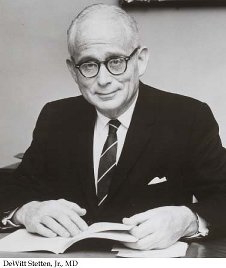
A Publication for Alumni & Friends of Rutgers Robert Wood Johnson Medical School

Did You Know? | Fall 2025
Next year, Rutgers Robert Wood Johnson Medical School will celebrate its 60th anniversary. While there are many big things happening, including a move into a brand-new building, this milestone presents an opportunity to look back on all that has been accomplished and the changes that have evolved over the years.

DeWitt Stetten Jr., MD, was appointed founding dean of the Rutgers School of Medicine in 1962, and in 1966 the first class walked through the doors. At that time the school was set up as a two-year program, where students would earn a master's degree in medical science. However, Dean Stetton noted that it was only a matter of time before he got his four-year school, especially if the program, faculty, and students exhibited excellence in medical education. In 1972, the New Jersey legislature gave a four-year school its approval, and the first students graduated with their MD degrees in 1974.
Initially the school was housed in temporary buildings, akin to trailers or shipping containers. They were not meant to be forever homes. Buildings needed to come to fruition. To figure out what kind of architecture to use and to collect ideas for the buildings, Dr. Stetton traveled with an architect to California to look at Stanford and the University of Southern California. He also toured a Bell Laboratories building.
Dr. Stetton sounds awestruck by what he saw: “Here for the first time I studied a totally glass-enclosed building with exterior corridors and windowless rooms.” The subsequent design of the buildings led to what we have now. Seen below are the footprints for the Piscataway campus. Notice how empty the landscape was near the campus!



The statue of Hippocrates was donated to the school in 1973. One of five similar statues of Hippocrates sculpted by Costos N. Georgakas and donated to universities throughout the United States, it has been moved at least twice to accommodate an evolving campus. It was donated to the campus by Mr. and Mrs. Peter Sideris and features Hippocrates' name in Greek, as well as the full wording of the Hippocratic Oath.
If you have any photos or interesting facts about the medical school, please let us know by sending an email to rwjmscpa@rwjms.rutgers.edu.
